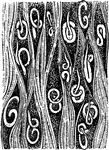This gallery offers 156 ClipArt images of worms. Worms are a general term given to many invertebrate animals that have a long, soft body and no legs.

Tapeworm
Tapeworms are parasites in the digestive tube of various vertebrates, including man. this is the much…
Tapeworm
"The Tapeworm is an intestinal worm, Tænia solium, in form somewhat resembling tape. Its length…
!["The Tapeworm is an intestinal worm, Tænia solium, in form somewhat resembling tape. Its length is from 5 to 15 yards, and its breadth from two lines at the narrowest part to four or five at the other or broader extremity. At the narrow end is the head, which is terminated anteriorly by a central rostellum, surrounded by a crown of small recurved hooks, and behind them four suctorial depressions; then follow an immense number of segments, each full of microscopic ova. The segments are capable of being detached when mature, and reproducing the parasite. There is no mouth; but nutrition appears to take place through the tissues of the animal, as algæ derive nourishment from the sea water in which they float. The digestive system consists of two tubes or lateral canals, extending from the anterior to the posterior end of the body, and a transverse canal at the summit of each joint. [Pictured] A single segment or proglottis magnified; 1, generating pore; 2, water vessels; 3, dendritic ovary."—(Charles Leonard-Stuart, 1911)](https://etc.usf.edu/clipart/16500/16595/tapeworm2_16595_mth.gif)
Tapeworm
"The Tapeworm is an intestinal worm, Tænia solium, in form somewhat resembling tape. Its length…
!["The Tapeworm is an intestinal worm, Tænia solium, in form somewhat resembling tape. Its length is from 5 to 15 yards, and its breadth from two lines at the narrowest part to four or five at the other or broader extremity. At the narrow end is the head, which is terminated anteriorly by a central rostellum, surrounded by a crown of small recurved hooks, and behind them four suctorial depressions; then follow an immense number of segments, each full of microscopic ova. The segments are capable of being detached when mature, and reproducing the parasite. There is no mouth; but nutrition appears to take place through the tissues of the animal, as algæ derive nourishment from the sea water in which they float. The digestive system consists of two tubes or lateral canals, extending from the anterior to the posterior end of the body, and a transverse canal at the summit of each joint. [Pictured] Head of tænia solium (enlarged)."—(Charles Leonard-Stuart, 1911)](https://etc.usf.edu/clipart/16500/16599/tapeworm3_16599_mth.gif)
Tapeworm
"The Tapeworm is an intestinal worm, Tænia solium, in form somewhat resembling tape. Its length…
!["The Tapeworm is an intestinal worm, Tænia solium, in form somewhat resembling tape. Its length is from 5 to 15 yards, and its breadth from two lines at the narrowest part to four or five at the other or broader extremity. At the narrow end is the head, which is terminated anteriorly by a central rostellum, surrounded by a crown of small recurved hooks, and behind them four suctorial depressions; then follow an immense number of segments, each full of microscopic ova. The segments are capable of being detached when mature, and reproducing the parasite. There is no mouth; but nutrition appears to take place through the tissues of the animal, as algæ derive nourishment from the sea water in which they float. The digestive system consists of two tubes or lateral canals, extending from the anterior to the posterior end of the body, and a transverse canal at the summit of each joint. [Pictured] A, ovum with contained embryo, B, Cystericus longicollis."—(Charles Leonard-Stuart, 1911)](https://etc.usf.edu/clipart/16600/16600/tapeworm4_16600_mth.gif)
Tapeworm
"The Tapeworm is an intestinal worm, Tænia solium, in form somewhat resembling tape. Its length…

Tapeworm
This diagram shows some stages in the life history of the tapeworm. A, Cysticercus or Bladderworm stage,…

Tapeworm
"Diagram showing some stages in the life history of the Tapeworm (taenia). A, Cysticercus or Bladderworm…
Tapeworm
Echinobothrium typus is a species of tapeworm distinguished by two fossettes with hooks on its head.

Tapeworm
The cestodes or tapeworms (Toenia solium), are parasitic flatworms. The body is usually of great length…

Pork Tapeworm
"Life history of Taenia solium. 1. Six-hooked embryo in egg-case; 2. proscolex or bladder-worm stage,…
Threadworm
Threadworm (Nematodes) or Roundworm is composed of many different species. In all the body is slender…
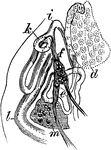
Reproductive Organs of Trematoid Worm
"Reproductive Organs of a Trematoid Worm (Aspidogaster conchicola). d, germarium; e, internal vas deferens;…

Trichina
The most dangerous of the parasitic round-worms is Trichina. This is trichina encysted in human muscle.

Trichina Spiralis
"Trichina Spiralis is the name given to a peculiar nematoid worm which inhabits the muscles, usually…

Trichina Spiralis
"Trichina Spiralis is the name given to a peculiar nematoid worm which inhabits the muscles, usually…

Trichinae
"Trichinae in muscle, encapsuled. There may be 12,000 in a gramme of pig's muscle." -Thomson, 1916
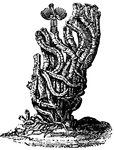
Calcareous Tubeworm (Serpula)
This worm is also called a fan worm, plume worm or red tube worm. "A Linnean genus of worms, subsequently…
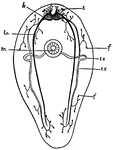
Turbellarian
This is a diagram of a Turbellarian, showing the general arrangement of the nervous structures and one…

Turbellarian
This is a diagram of transverse section of a Turbellarian through the region of the mouth. d.m., dermo-muscular…
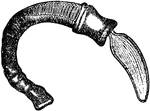
Acorn Worm
"Young Balanoglossus: showing proboscis, collar, gill-slits, and gastric region. Balanoglossus, a worm-like…

Marine Worm
Marine worms, also known as Nereis, a worm with highly developed heads and many bristles arranged along…
Marine Worm
Marine worms, also known as Nereis, a worm with highly developed heads and many bristles arranged along…
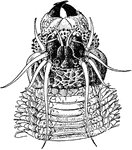
Marine Worm
Marine worms, also known as Nereis, a worm with highly developed heads and many bristles arranged along…
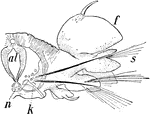
Marine Worm
Marine worms, also known as Nereis, a worm with highly developed heads and many bristles arranged along…
Marine Worm
Marine worms (Polynoe bevisetosa), a worm with highly developed heads and many bristles arranged along…
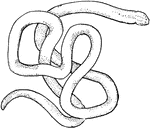
Nemetean
Band or Nemetean worms have been discovered in damp soil or in fresh-water streams. These are commonly…

Nemetean
Band or Nemetean worms have been discovered in damp soil or in fresh-water streams. These are commonly…
Worms
This illustration shows a worm. Worms have an elongated soft-body. The most famous is the earthworm,…


